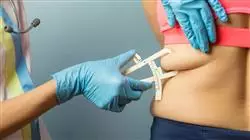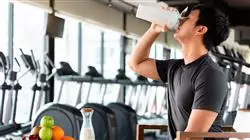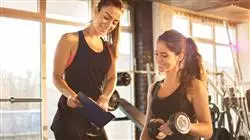University certificate
The world's largest faculty of nutrition”
Why study at TECH?
Proper nutrition is essential when performing intense physical activity, which is why many athletes seek the services of nutritionists for better advice”

Changes in society have encouraged the practice of sports in practically all age groups. Therefore, it is not surprising that more and more people decide to seek nutritional advice from professionals to improve their physical condition and avoid any possible risks when exercising. As a result, it is no longer only elite athletes who are concerned about following a proper diet to improve their performance, but people of all ages: young people, adults and even seniors, feel the need to turn to specialized nutritionists to guide them in the nutritional field, taking into account their physical condition and the exercise they do.
Therefore, nutritionists have found a new job opportunity in the sports field upon which to focus their knowledge, not only at the level of professional athletes, but also at an amateur level, having to obtain a higher level of qualification in order to deal with specific populations who have found physical exercise to be a good way to improve their health. For this reason, this Advanced master’s degree at TECH offers nutritionists the most complete information on the subject, enabling them to obtain a superior specialization that will allow them to work with a large proportion of the population who are looking for specialists in this sector to help them improve their physical conditions.
Accordingly, the program provides a global vision of sports nutrition, while focusing on the most important and innovative aspects such as invisible training or proper diet for athletes, and nutrition before, during and after exercise. Additionally, it includes information related to professionals with different personal situations and who practice different sporting activites, specifying in each case the best dietary recommendations, with the objective that the nutritionist has comprehensive knowledge that allows them to adapt to each individual during their daily practice.
For this purpose, TECH proposes an innovative study method, in which practice is the key to effective learning. So, with this completely original methodology, professionals will have the opportunity to combine theoretical study with practical cases, in such a way that learning will be much more effective and efficient. And all this is in a 100% online format, which will allow students to study from anywhere in the world, without having to physically make unnecessary trips to a classroom, allowing them to self-manage their study time as they wish. A unique opportunity that will be indispensable for your professional development.
Immerse yourself in the study of the latest concepts in sports nutrition and develop the ability to effectively advise your clients"
This Advanced master’s degree in Comprehensive Sports Nutrition contains the most complete and up-to-date scientific program on the market. The most important features include:
- The latest technology in online teaching software
- A highly visual teaching system, supported by graphic and schematic contents that are easy to assimilate and understand
- Practical case studies presented by practising experts
- State-of-the-art interactive video systems
- Teaching supported by remote education
- Continuous updating and retraining systems
- Autonomous learning: full compatibility with other occupations
- Practical exercises for self-evaluation and learning verification
- Support groups and educational synergies: questions to the expert, debate and knowledge forums
- Communication with the teacher and individual reflection work
- Content that is accessible from any, fixed or portable device with an Internet connection
- Complementary resource banks that are permanently available
This program will enable you to acquire new skills and knowledge in a smooth and efficient manner"
The teaching staff for this program is composed of practising professionals. This way, TECH can fulfill the objective of academic updating that it has set for itself. A multidisciplinary staff of experienced professionals from a variety of environments, who will develop theoretical knowledge in an efficient manner, but above all, will provide students with practical knowledge derived from their own experience.
This command of the subject is complemented by the effectiveness of the methodological design of this Advanced master’s degree. As such, it was developed by a multidisciplinary team of e-learning experts and integrates the latest advances in educational technology, allowing students to study with a range of convenient and versatile multimedia tools that will give them the operational skills they need for their profession.
The design of this program is based on Problem-Based Learning, an approach that conceives learning as a highly practical process. To achieve this remotely, TECH will use telepractice. With the help of an innovative interactive video system and Learning from an Expert, students will be able to acquire the knowledge as if they were facing the scenario they are currently learning about. A concept that will allow students to integrate and memorize what they have learnt in a more realistic and permanent way.
This 100% online Advanced master’s degree will allow you to combine your studies with your professional work while increasing your knowledge in this field"

TECH offers you the best teaching methodology and a variety of case studies that will make the theoretical concepts more understandable"
Syllabus
The structure and contents of this Advanced master’s degree in Comprehensive Sports Nutrition have been designed taking into account the academic needs of nutrition professionals who are encountering more and more athletes in their practices who decide to consume diets adapted to their physical condition. For this reason, TECH has designed a comprehensive academic program, which shows the specific aspects of each type of athlete, including those with special characteristics.

Acquire advanced knowledge in sports nutrition thanks to this comprehensive program"
Block 1. Nutrition in Physical Activity and Sport
Module 1. New Developments in Food
1.1. Molecular Foundations of Nutrition
1.2. Update on Food Composition
1.3. Food Composition Tables and Nutritional Databases
1.4. Phytochemicals and Non-Nutritive Compounds
1.5. New Food
1.5.1. Functional Nutrients and Bioactive Compounds
1.5.2. Probiotics, Prebiotics, and Synbiotics
1.5.3. Quality and Design
1.6. Organic food
1.7. Transgenic Foods
1.8. Water as a Nutrient
1.9. Food Safety
1.9.1. Physical Hazards
1.9.2. Chemical Hazards
1.9.3. Microbiological Hazards
1.10. New labeling and consumer information
1.11. Phytotherapy Applied to Nutritional Pathologies
Module 2. Current Trends in Nutrition
2.1. Nutrigenetics
2.2. Nutrigenomics
2.2.1. Fundamentals
2.2.2. Methods
2.3. Immunonutrition
2.3.1. Nutrition-Immunity Interactions
2.3.2. Antioxidants and Immune Function
2.4. Physiological Regulation of Feeding. Appetite and Satiety
2.5. Psychology and Nutrition
2.6. Nutrition and Sleep
2.7. Update on Nutritional Objectives and Recommended Intakes
2.8. New Evidence on the Mediterranean Diet
Module 3. Assessment of Nutritional Status and Diet. Practical Application
3.1. Bioenergy and Nutrition
3.1.1. Energy Needs
3.1.2. Methods of Assessing Energy Expenditure
3.2. Assessment of Nutritional Status
3.2.1. Body Composition Analysis
3.2.2. Clinical Diagnosis. Symptoms and Signs
3.2.3. Biochemical, Hematological and Immunological Methods
3.3. Intake Assessment
3.3.1. Methods for Analyzing Food and Nutrient Intake
3.3.2. Direct and Indirect Methods
3.4. Update on Nutritional Requirements and Recommended Intakes
3.5. Nutrition in a Healthy Adult. Objectives and Guidelines. Mediterranean Diet
3.6. Nutrition in Menopause
3.7. Nutrition in the Elderly
Module 4. Sports Nutrition
4.1. Physiology of Exercise
4.2. Physiological Adaptation to Different Types of Exercise
4.3. Metabolic Adaptation to Exercise. Regulation and Control
4.4. Assessing Athletes' Energy Needs and Nutritional Status
4.5. Assessing Athletes’ Physical Ability
4.6. Nutrition in the Different Phases of Sports Practice
4.6.1. Pre-Competition
4.6.2. During
4.6.3. Post-Competition
4.7. Hydration
4.7.1. Regulation and Needs
4.7.2. Types of Beverages
4.8. Dietary Planning Adapted to Different Sports
4.9. Ergogenic Aids and Current Anti-Doping Regulations
4.9.1. AMA and AEPSAD Recommendations
4.10. Nutrition in Sports Injury Recovery
4.11. Psychological Disorders Related to Practising Sport
4.11.1. Eating Disorders: Bigorexia, Orthorexia, Anorexia
4.11.2. Fatigue Caused by Overtraining
4.11.3. The Female Athlete Triad
4.12. The Role of the Coach in Sports Performance
Block 2. Nutrition for Special Populations in Physical Activity and Sport
Module 5. Muscle and Metabolic Physiology Associated with Exercise
5.1. Cardiovascular Adaptations Related to Exercise
5.1.1. Increased Systolic Volume
5.1.2. Decreased Heart Rate
5.2. Ventilatory Adaptations Related to Exercise
5.2.1. Changes in the Ventilatory Volume
5.2.2. Changes in Oxygen Consumption
5.3. Hormonal Adaptations Related to Exercise
5.3.1. Cortisol
5.3.2. Testosterone
5.4. Muscle Structure and Types of Muscle Fibers
5.4.1. Muscle Fiber
5.4.2. Type I Muscle Fibers
5.4.3. Type II Muscle Fibers
5.5. The Concept of Lactic Threshold
5.6. ATP and Phosphagen Metabolism
5.6.1. Metabolic Pathways for ATP Resynthesis during Exercise
5.6.2. Phosphagen Metabolism
5.7. Carbohydrate Metabolism
5.7.1. Carbohydrate Mobilization during Exercise
5.7.2. Types of Glycolysis
5.8. Lipid Metabolism
5.8.1. Lipolysis
5.8.2. Fat Oxidation during Exercise
5.8.3. Ketone Bodies
5.9. Protein Metabolism
5.9.1. Ammonium Metabolism
5.9.2. Amino Acid Oxidation
5.10. Mixed Bioenergetics of Muscle Fibers
5.10.1. Energy Sources and their Relation to Exercise
5.10.2. Factors Determining the Use of One or Another Energy Source during Exercise
Module 6. The Evaluation of the Athlete at Different Moments of the Season
6.1. Biochemical Evaluation
6.1.1. Blood count:
6.1.2. Overtraining Markers
6.2. Anthropometric Evaluation
6.2.1. Body Composition
6.2.2. ISAK Profile
6.3. Preseason
6.3.1. High Workload
6.3.2. Assuring Caloric and Protein Intake
6.4. Competitive Season
6.4.1. Sports Performance
6.4.2. Recovery between Games
6.5. Transition Period
6.5.1. Vacation Period
6.5.2. Changes in Body Composition
6.6. Travel
6.6.1. Tournaments during the Season
6.6.2. Off-season Tournaments (World Cups, European Cups and The Olympic Games)
6.7. Athlete Monitoring
6.7.1. Basal Athlete Status
6.7.2. Evolution during the Season
6.8. Sweat Rate Calculation
6.8.1. Hydric losses
6.8.2. Calculation Protocol
6.9. Multidisciplinary Work
6.9.1. The Role of the Nutritionist in the Athlete's Environment
6.9.2. Communication with the Rest of the Areas
6.10. Doping
6.10.1. WADA List
6.10.2. Anti-doping Tests
Module 7. Watersports
7.1. History of Watersports
7.1.1. Olympics and Major Tournaments
7.1.2. Watersports Today
7.2. Performance Limitations
7.2.1. Aquatic Sports in the Water (Swimming, Water Polo, etc.)
7.2.2. Aquatic Sports on the Water (Surfing, Sailing, Canoeing, etc.)
7.3. The Basic Characteristics of Water Sports
7.3.1. Aquatic Sports in the Water (Swimming, Water polo, etc.)
7.3.2. Aquatic Sports on the Water (Surfing, Sailing, Canoeing, etc.)
7.4. Aquatic Sports Physiology
7.4.1. Energy Metabolism
7.4.2. Athlete Biotype
7.5. Training
7.5.1. Strength
7.5.2. Resistance
7.6. Body Composition
7.6.1. Swimming
7.6.2. Water Polo
7.7. Precompetition
7.7.1. 3 Hours Before
7.7.2. 1 Hour Before
7.8. Post-Competition
7.8.1. Carbohydrates
7.8.2. Hydration
7.9. Post-Competition
7.9.1. Hydration
7.9.2. Protein
7.10. Ergogenic Aids
7.10.1. Creatine
7.10.2. Caffeine
Module 8. Adverse Conditions
8.1. The History of Sport in Extreme Conditions
8.1.1. Winter Competitions throughout History
8.1.2. Competitions in Hot Environments Today
8.2. Performance Limitations in Hot Climates
8.2.1. Dehydration
8.2.2. Fatigue
8.3. Basic Characteristics in Hot Climates
8.3.1. High Temperature and Humidity
8.3.2. Acclimatization
8.4. Nutrition and Hydration in Hot Climates
8.4.1. Hydration and Electrolytes
8.4.2. Carbohydrates
8.5. Performance Limitations in Cold Climates
8.5.1. Fatigue
8.5.2. Bulky Clothing
8.6. Basic Characteristics in Cold Climates
8.6.1. Extreme Cold
8.6.2. Reduced VOmax
8.7. Nutrition and Hydration in Cold Climates
8.7.1. Hydration
8.7.2. Carbohydrates
Module 9. Vegetarianism and Veganism
9.1. Vegetarianism and Veganism in the History of Sport
9.1.1. The Beginnings of Veganism in Sport
9.1.2. Vegetarian Athletes Today
9.2. Different Types of Vegan Food
9.2.1. The Vegan Athlete
9.2.2. The Vegetarian Athlete
9.3. Common Errors in the Vegan Athlete
9.3.1. Energy Balance
9.3.2. Protein Consumption
9.4. Vitamin B12
9.4.1. B12 Supplementation
9.4.2. Bioavailability of Spirulina Algae
9.5. Protein Sources in the Vegan/Vegetarian Diet
9.5.1. Protein Quality
9.5.2. Environmental Sustainability
9.6. Other Key Nutrients in Vegans
9.6.1. Conversion of ALA to EPA/DHA
9.6.2. Fe, Ca, Vitamin D and Zn
9.7. Biochemical Assessment/Nutritional Deficiencies
9.7.1. Anaemia
9.7.2. Sarcopenia
9.8. Vegan Diet vs. Omnivorous Diet
9.8.1. Evolutionary Food
9.8.2. Current Food
9.9. Ergogenic Aids
9.9.1. Creatine
9.9.2. Vegetable Protein
9.10. Factors that Decrease Nutrient Absorption
9.10.1. High Fiber Intake
9.10.2. Oxalates
Module 10. The Type 1 Diabetic Athlete
10.1. Knowing about Diabetes and its Pathology
10.1.1. The Incidence of Diabetes
10.1.2. Pathophysiology of Diabetes
10.1.3. The Consequences of Diabetes
10.2. Exercise Physiology in People with Diabetes
10.2.1. Maximal, Submaximal Exercise and Muscle Metabolism during Exercise
10.2.2. Differences in the Metabolic Level during Exercise in People with Diabetes
10.3. Exercise in People with Type 1 Diabetes
10.3.1. Exercise in People with Type 1 Diabetes
10.3.2. Exercise Duration and Carbohydrate Intake
10.4. Exercise in People with Type 2 Diabetes. Blood Sugar Control
10.4.1. Risks of Physical Activity in People with Type 2 Diabetes
10.4.2. Benefits of Exercise in People with Type 2 Diabetes
10.5. Exercise in Children and Adolescents with Diabetes
10.5.1. Metabolic Effects of Exercise
10.5.2. Precautions during Exercise
10.6. Insulin Therapy and Exercise
10.6.1. Insulin Infusion Pump
10.6.2. Types of Insulins
10.7. Nutritional Strategies during Sport and Exercise in Type 1 Diabetes
10.7.1. From Theory to Practice
10.7.2. Carbohydrate Intake Before, During and After Physical Exercise
10.7.3. Hydration Before, During and After Physical Exercise
10.8. Nutritional Planning in Endurance Sports
10.8.1. Marathon
10.8.2. Cycling
10.9. Nutritional Planning in Team Sports
10.9.1. Soccer
10.9.2. Rugby
10.10. Sports Supplements and Diabetes
10.10.1. Potentially Beneficial Supplements for Athletes with Diabetes
Module 11. Para-Athletes
11.1. Classification and Categories in Para-Athletes
11.1.1. What is a Para Athlete?
11.1.2. How are Para Athletes Classified?
11.2. Sports Science in Para Athletes
11.2.1. Metabolism and Physiology
11.2.2. Biomechanics
11.2.3. Psychology
11.3. Energy Requirements and Hydration in Para-Athletes
11.3.1. Optimal Energy Demands for Training
11.3.2. Hydration Planning before, during and after Training and Competitions
11.4. Nutritional Problems in the Different Categories of Para Athletes According to Pathology or Anomaly
11.4.1. Spinal Cord Injuries
11.4.2. Cerebral Palsy and Acquired Brain Injuries
11.4.3. Amputees
11.4.4. Vision and Hearing Impairment
11.4.5. Intellectual Impairments
11.5. Nutritional Planning in Para Athletes with Spinal Cord Injury and Cerebral Palsy and Acquired Brain Injuries
11.5.1. Nutritional Requirements (Macro and Micronutrients)
11.5.2. Sweating and Fluid Replacement during Exercise
11.6. Nutritional Planning in Amputee Para Athletes
11.6.1. Energy Requirements
11.6.2. Macronutrients
11.6.3. Thermoregulation and Hydration
11.6.4. Nutritional Issues Related to Prosthetics
11.7. Planning and Nutritional Problems in Para Athletes with Vision-Hearing Impairment and Intellectual Impairment
11.7.1. Sports Nutrition Problems with Visual Impairment: Retinitis Pigmentosa, Diabetic Retinopathy, Albinism, Stargardt's Disease and Hearing Pathologies
11.7.2. Sports Nutrition Problems in Para-Athletes with Intellectual Deficiencies: Down Syndrome, Autism and Asperger's and Phenylketonuria
11.8. Body Composition in Para Athletes
11.8.1. Measurement Techniques
11.8.2. Factors Influencing the Reliability of Different Measurement Methods
11.9. Pharmacology and Nutrient Interactions
11.9.1. Different Types of Drugs Taken by Para Athletes
11.9.2. Micronutrient Deficiencies in Para Athletes
11.10. Ergogenic Aids
11.10.1. Potentially Beneficial Supplements for Para Athletes
11.10.2. Adverse Effects on Health and Contamination and Doping Problems Due to the Intake of Performance Enhancing drugs
Module 12. Sports by Weight Category
12.1. Characteristics of the Main Sports by Weight Category
12.1.1. Regulation
12.1.2. Categories
12.2. Programming of the Season
12.2.1. Competitions
12.2.2. Macrocycle
12.3. Body composition
12.3.1. Combat Sports
12.3.2. Weightlifting
12.4. Stages of Muscle Mass Gain
12.4.1. % Body Fat
12.4.2. Programming
12.5. Definition Stages
12.5.1. Carbohydrates
12.5.2. Protein
12.6. Precompetition
12.6.1. Peek Weak
12.6.2. Before Weighing
12.7. Precompetition
12.7.1. Practical Applications
12.7.2. Timing
12.8. Post-Competition
12.8.1. Hydration
12.8.2. Protein
12.9. Ergogenic Aids
12.9.1. Creatine
12.9.2. Whey Protein
Module 13. Different Stages or Specific Population Groups
13.1. Nutrition in the Female Athlete
13.1.1. Limiting Factors
13.1.2. Requirements
13.2. Menstrual Cycle
13.2.1. The Luteal Phase
13.2.2. Follicular Phase
13.3. Triad
13.3.1. Amenorrhea
13.3.2. Osteoporosis
13.4. Nutrition in the Pregnant Female Athlete
13.4.1. Energy Requirements
13.4.2. Micronutrients
13.5. The Effects of Physical Exercise on the Child Athlete
13.5.1. Strength Training
13.5.2. Endurance Training
13.6. Nutritional Education in the Child Athlete
13.6.1. Sugar
13.6.2. Eating Disorders
13.7. Nutritional Requirements in the Child Athlete
13.7.1. Carbohydrates
13.7.2. Proteins
13.8. Changes Associated with Aging
13.8.1. % Body Fat
13.8.2. Muscle Mass
13.9. Main Problems in the Older Athlete
13.9.1. Joints
13.9.2. Cardiovascular Health
13.10. Interesting Supplements for Older Athletes
13.10.1. Whey Protein
13.10.2. Creatine
Module 14. The Injury Period
14.1. Introduction
14.2. Prevention of Injuries in Athletes
14.2.1. Relative Energy Availability in Sport
14.2.2. Oral Health and Injury Implications
14.2.3. Fatigue, Nutrition and Injuries
14.2.4. Sleep, Nutrition and Injuries
14.3. Phases of Injury
14.3.1. Immobilization Phase. Inflammation and Changes Occurring during this Phase
14.3.2. Return of Activity Phase
14.4. Energy Intake during the Period of Injury
14.5. Macronutrient Intake during the Period of Injury
14.5.1. Carbohydrate Intake
14.5.2. Fat Intake
14.5.3. Protein Intake
14.6. Intake of Micronutrients of Special Interest during Injury
14.7. Sports Supplements with Evidence during the Period of Injury
14.7.1. Creatine
14.7.2. Omega 3
14.7.3. Others
14.8. Tendon and Ligament Injuries
14.8.1. Introduction to Tendon and Ligament Injuries. Tendon Structure
14.8.2. Collagen, Gelatin and Vitamin C. Can they Help?
14.8.3. Other Nutrients Involved in Collagen Synthesis
14.9. The Return to Competition
14.9.1. Nutritional Considerations in the Return to Competition
14.10. Interesting Case Studies in Scientific Injury Literature

An academic journey through the latest concepts in sports nutrition"
Advanced Master's Degree in Integrative Sports Nutrition
Maintaining an adequate diet is especially important for people involved in sports, since their intensive physical activity exposes the body to a significant expenditure of energy. For this reason, nutritional assistance is essential for athletes, since, with an adequate nutritional plan, they will be able to maintain an optimal state of performance. At TECH Global University we developed the Advanced Master's Degree in Comprehensive Sports Nutrition, a program aimed at updating your knowledge and technical skills in the field in order to provide quality nutritional support and optimize the condition and responsiveness of your patients in the processes of energy intake and repair of muscle tissue. In this way, you will be able to offer the best services in your consultations and increase your professional prestige.
Specialize at the largest School of Nutrition
If you want to stand out as an expert in this area offering a safe and effective service, with a solid base of knowledge and technical skills, this program is for you. Through a highly rigorous syllabus, you will learn about the energy and nutritional needs of athletes according to their situation (age, sex, exercise intensity, physical characteristics, sports goals and pathophysiology); you will develop the most advanced knowledge for the nutritional planning of professional and non-professional athletes; you will detect possible nutritional deficits and states of overtraining, and you will establish dietary strategies according to the requirements during the period of injury and muscle recovery. With the support of experts in the area and innovative methods in the study of the latest advances in this discipline, you will have within your reach new skills that will help you make accurate and effective decisions to ensure a comprehensive and high quality service in your work practice.







